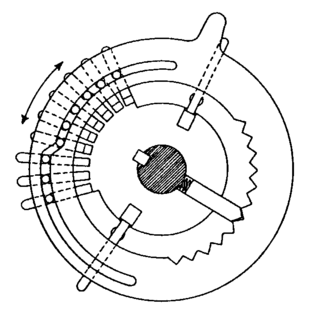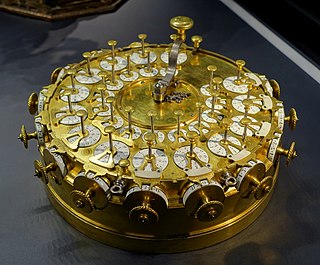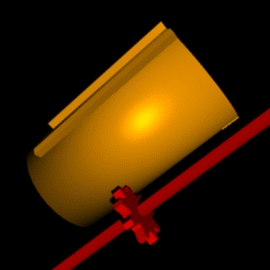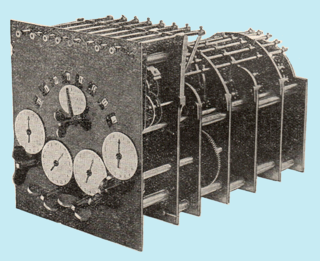
An analog computer or analogue computer is a type of computer that uses the continuous variation aspect of physical phenomena such as electrical, mechanical, or hydraulic quantities to model the problem being solved. In contrast, digital computers represent varying quantities symbolically and by discrete values of both time and amplitude.

An electronic calculator is typically a portable electronic device used to perform calculations, ranging from basic arithmetic to complex mathematics.

The history of computing hardware covers the developments from early simple devices to aid calculation to modern day computers.

An adding machine is a class of mechanical calculator, usually specialized for bookkeeping calculations. In the United States, the earliest adding machines were usually built to read in dollars and cents. Adding machines were ubiquitous office equipment until they were phased out in favor of calculators in the 1970s and by personal computers beginning in about 1985. The older adding machines were rarely seen in American office settings by the year 2000.

This article presents a detailed timeline of events in the history of computing software and hardware: from prehistory until 1949. For narratives explaining the overall developments, see History of computing.
A music sequencer is a device or application software that can record, edit, or play back music, by handling note and performance information in several forms, typically CV/Gate, MIDI, or Open Sound Control, and possibly audio and automation data for digital audio workstations (DAWs) and plug-ins.

Leonardo Torres Quevedo was a Spanish civil engineer, mathematician, and inventor of the late 19th century and early 20th century. A member of the Royal Spanish Academy since 1920, he was also a corresponding member of the French Academy of Sciences, among other institutions. Torres was a prolific and versatile innovator in various fields of engineering, including mechanics, aeronautics and automatics. One of his greatest achievements was El Ajedrecista of 1912, an electromagnetic device capable of playing a limited form of chess that demonstrated the capability of machines to be programmed to follow specified rules (heuristics) and marked the beginnings of research into the development of artificial intelligence.

Wilhelm Schickard was a German professor of Hebrew and astronomy who became famous in the second part of the 20th century after Franz Hammer, a biographer of Johannes Kepler, claimed that the drawings of a calculating clock, predating the public release of Pascal's calculator by twenty years, had been discovered in two unknown letters written by Schickard to Johannes Kepler in 1623 and 1624.

The history of computing is longer than the history of computing hardware and modern computing technology and includes the history of methods intended for pen and paper or for chalk and slate, with or without the aid of tables.

A mechanical calculator, or calculating machine, is a mechanical device used to perform the basic operations of arithmetic automatically, or (historically) a simulation such as an analog computer or a slide rule. Most mechanical calculators were comparable in size to small desktop computers and have been rendered obsolete by the advent of the electronic calculator and the digital computer.

Pascal's calculator is a mechanical calculator invented by Blaise Pascal in 1642. Pascal was led to develop a calculator by the laborious arithmetical calculations required by his father's work as the supervisor of taxes in Rouen. He designed the machine to add and subtract two numbers directly and to perform multiplication and division through repeated addition or subtraction.

A pinwheel calculator is a class of mechanical calculator described as early as 1685, and popular in the 19th and 20th century, calculating via wheels whose number of teeth were adjustable. These wheels, also called pinwheels, could be set by using a side lever which could expose anywhere from 0 to 9 teeth, and therefore when coupled to a counter they could, at each rotation, add a number from 0 to 9 to the result. By linking these wheels with carry mechanisms a new kind of calculator engine was invented. Turn the wheels one way and one performs an addition, the other way a subtraction.

Johann Helfrich von Müller was an engineer in the Hessian army who conceived the difference engine in 1786, an idea that later evolved into modern computers. In 1784, he was responsible for an improved adding machine based on principles of Leibniz's stepped reckoner.

The history of computer science began long before the modern discipline of computer science, usually appearing in forms like mathematics or physics. Developments in previous centuries alluded to the discipline that we now know as computer science. This progression, from mechanical inventions and mathematical theories towards modern computer concepts and machines, led to the development of a major academic field, massive technological advancement across the Western world, and the basis of a massive worldwide trade and culture.

Sound Blaster Live! is a PCI add-on sound card from Creative Technology Limited for PCs. Moving from ISA to PCI allowed the card to dispense with onboard memory, storing digital samples in the computer's main memory and then accessing them in real time over the bus. This allowed for a much wider selection of, and longer playing, samples. It also included higher quality sound output at all levels, quadrophonic output, and a new MIDI synthesizer with 64 sampled voices. The Live! was introduced in August 1998 and variations on the design remained Creative's primary sound card line into the early 2000's.

A computer is a machine that can be programmed to automatically carry out sequences of arithmetic or logical operations (computation). Modern digital electronic computers can perform generic sets of operations known as programs. These programs enable computers to perform a wide range of tasks. The term computer system may refer to a nominally complete computer that includes the hardware, operating system, software, and peripheral equipment needed and used for full operation; or to a group of computers that are linked and function together, such as a computer network or computer cluster.

A mechanical computer is a computer built from mechanical components such as levers and gears rather than electronic components. The most common examples are adding machines and mechanical counters, which use the turning of gears to increment output displays. More complex examples could carry out multiplication and division—Friden used a moving head which paused at each column—and even differential analysis. One model, the Ascota 170 accounting machine sold in the 1960s, calculated square roots.

A Leibniz wheel or stepped drum is a cylinder with a set of teeth of incremental lengths which, when coupled to a counting wheel, can be used in the calculating engine of a class of mechanical calculators. Invented by Leibniz in 1673, it was used for three centuries until the advent of the electronic calculator in the mid-1970s.

The Arithmaurel was a mechanical calculator that had a very intuitive user interface, especially for multiplying and dividing numbers because the result was displayed as soon as the operands were entered. It was first patented in France by Timoleon Maurel, in 1842. It received a gold medal at the French national show in Paris in 1849. Its complexity and the fragility of its design prevented it from being manufactured.